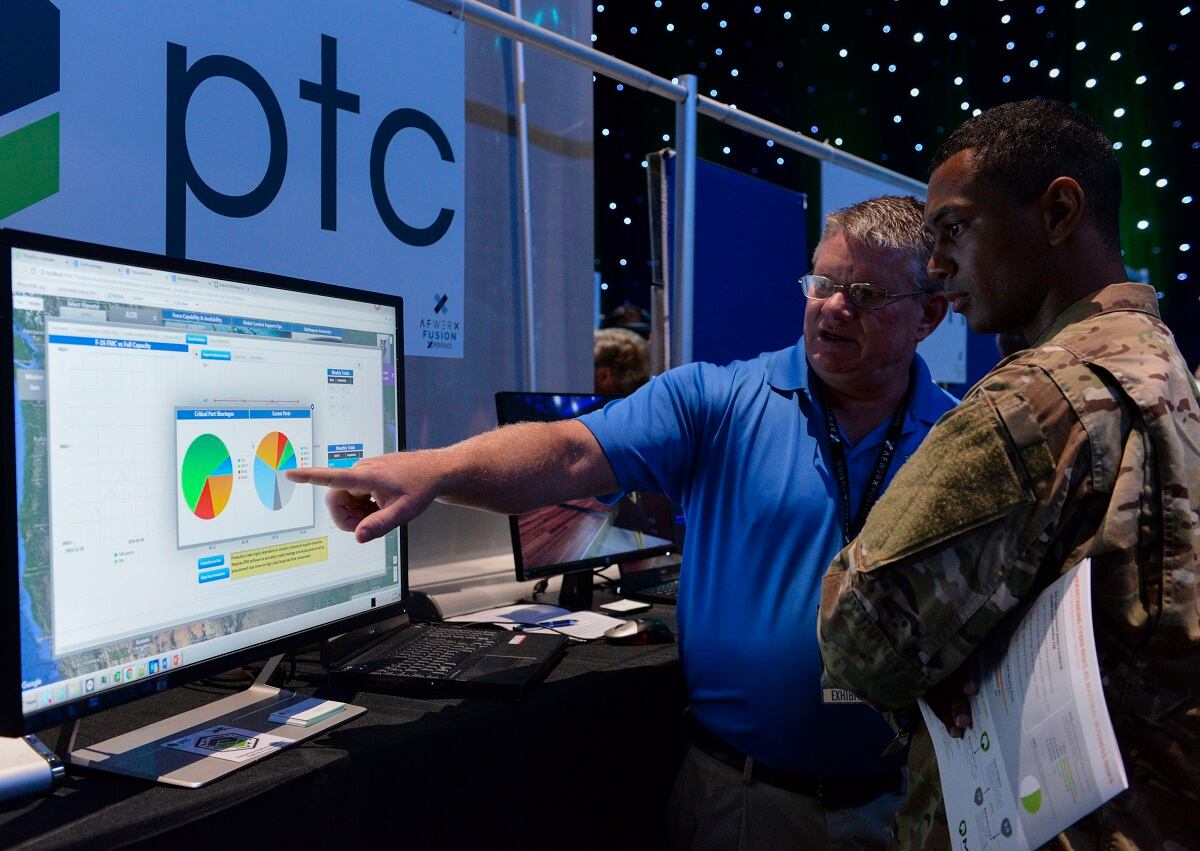WASHINGTON — News that SAIC would buy Engility was just the latest in a recent string of acquisitions among the professional services firms. But if you ask the CEO of SAIC, Tony Moraco, unlike some of the company’s peers this was not transformational. This was instead a merging of two complementary businesses. In his words, “a momentum builder, as we are stronger together in the marketplace.”
It’s also the next phase for a company that technically formed five years ago, with the split of the $11 billion legacy company with the same name.
Defense News sat down with Moraco to see how the acquisition fits into SAIC’s future strategy, and how far the company has come since gaining independence.
About a year after SAIC split from Leidos, I asked you about your vision for the company. And you said to return to an $11 billion company. How does this acquisition fit into your vision for SAIC these days?
The Engility acquisition is very much consistent with our current strategy. It is not a deviation or a reset, as perhaps some of the other major transactions have been for some of our peers. But it really is about the theme of being stronger together, with [particular] compatibility of the intelligence community … and also attributes in space market segments that we think we can both serve better. For us, this is opening market access to channels that we didn’t have.
It’s momentum building, a vision and a strategy that was five years in the making, and it’s a continuation of that strategy going forward.
RELATED

So have you been looking for an extended period of time? And why Engility specifically?
We consistently look at the market. We were not going to be a high-volume buyer, but more selective. The Scitor [acquisition] was more than three years ago. But we felt that we had a good position in the marketplace to grow organically. And we proved very strong performance over five years and since [that last acquisition of] Scitor. And then we’ve looked at many deals, large and small, to see what makes the most sense to us, staying true to our strategy.
The attraction with Engility was probably first sparked by the multi-intelligence agency portfolio that they have. Instead of buying a number of smaller concentrated firms, we could get a couple agencies in one larger deal. The company is large enough, they have a mature system. Again, in contrast to perhaps some of the small businesses, we think it has been through its own cultural shift to align very much to ours.
Also of interest is the space market. Today, with denied access and with the threats that we have, space is becoming a much more serious domain. The U.S. wants to invest more in it for a range of reasons. And when we think about space, it does cross, in fact, with the intelligence community, the defense sector with Air Force and the other services, and then also the civilian agencies with NASA, [and the National Oceanic and Atmospheric Administration].

As that market evolves, I think the U.S. government will be a principal customer. I believe that the commercial space entities will find a way where they’ll also require key outsourced space services just as the government had.
So for a single transaction at scale where we could in fact use our equity, [and face] probably fewer buyers, filling three or four of our strategic initiatives in market access and in capabilities — we felt it was worth a serious look. But it’s not just about space and intel. Defense will still be the largest part of our portfolio — 55 percent after we close [from 61 percent]. With the benefit of having the broader diversification in intel and federal civilian agencies, that serves all of our customers from a technology transfer perspective.
We’ve seen an interesting transition in the market, where the big primes are shedding portions of their services segments. Have we officially returned to the days when manufacturers focus on platforms only and leave the rest to the professional services companies?
I think we [for a period of time] faced a market that was uncertain. Our customers were reprioritizing their mission areas, and the industry was doing the same — looking at where they were going to focus their precious dollars, identify businesses they were going to protect, and areas that maybe weren’t core. Then as the market started to improve and move away from cost reductions to protect margins to having some cash and some flexibility, you started seeing more portfolio shaping from the larger players.
It’s not just about scale. There’s [a focus on] the diversification because as you know, the whole business is based on past performance and on what qualifications you have in people and in contract vehicles; if you have a broader base concentrated in a few key areas, your ability to compete and win in those domains is improved.
There are a lot of technologies that are more heavily influencing the battlefield — whether ISR, electronic warfare, even still cyber, which is evolving. It seems those areas don’t fit quite as neatly in one model or the other.
We’ve been around. It’s not a body shop service that we run. It is services and solutions. But technology integration is a direct link to the customer’s demand for modernization, the interest in innovative solutions from nontraditional players, the ability to field capabilities faster in a much shorter development cycle, and that leads you to a technology integration model that we have.
RELATED

It allows us to take mission understanding and translate requirements into capability needs. So we can integrate, we can innovate with the technology and we can implement the solutions, which is fundamentally what the customer needs to migrate them from a current state to a future state.
But we’re seeing more and more opportunities through the [Defense Innovation Unit], the [other transaction authorities], and other contract vehicles that provide a little more rapid prototyping flexibility.
SAIC bid for the Marine Corps Amphibious Combat Vehicle and is now working to compete for the Army’s Mobile Protected Firepower program.How does that all fit into the broader strategy?
We do see it as a viable area, and I would characterize it as the next tier of complex technology integration, system integration. It’s an extension of our command-and-control and ISR integration. I recall we pushed through 30,000 MRAP systematic build packages. That kind of integration of subsystems into a platform is what we felt was a baseline business that we could look to expand; and as the customer looked at, in this case, starting with Assault Amphibious Vehicle. Not a start-from-scratch build — the survivability upgrade really was around the armor, the underbelly and then your armaments protecting the vehicle. And then the related mobility requirements to change out transmissions and engines to support that extra weight. We felt that those subsystems and our mission knowledge afforded us the ability to extend to a little more of the physical platform itself.
We’re doing work on the next-gen combat vehicle. And we’re using a services model for MPF. Again, nondevelopmental, major integration of existing platforms for rapid field development. That fits well into our technology and integration model.
We see the ground vehicles and perhaps maritime [areas] as one that was probably more approachable versus, say, airframes. Modernization of aircraft has its own barriers of entry of getting flight readiness and the like.
We’ve extended our test-equipment knowledge to partnering with Lockheed on the propulsion system for torpedoes, for example. So we’re just looking for selective areas to do more complex system integration under this broad technology integration umbrella. It just happens to be bigger subsystems. Complex system integration sets us apart from some of the current peers in the marketplace right now. But we’re selective in what we go after.
How hard of a hit was the loss of the Marine Corps Amphibious Combat Vehicle in moving forward with that?
It’s disappointing. We try to be practical and objective about our market position. It’s an alternative model. It’s still early in the life cycle. But I think that as we see different opportunities, we learn from it as the customers get more comfortable. So yes, disappointing on ACV, but at the same time we learned a lot from it and I think the customer ultimately got a very good result by having a competitive phase.
And we think that the Army [with MPF] will be as successful and come up with [the] best solution if they can maintain a competitiveness early in the process.
When the split first happened, you and Leidos were generally two different companies. With this acquisition, and with the Leidos acquisition from Lockheed, have you all started to mirror each other more?
I think we may be looking a little more alike. Five years ago I did not expect it. I think we had very clear strategies that [we] were intending to diverge, and therefore we did not have any formal noncompetes. We were looking at the services business model, and Leidos was looking to do more system development. I think their execution of that didn’t play out as fast as they’d like. Roger [Krone, Leidos CEO], buying back in the services, more of the information system side, was a bit of a surprise. So if anything, they came back towards us versus us changing direction.
So I’d say they probably navigated slightly different than expected. But even today we’re still two different companies. We’re still very focused on letting our investors and customers know what we do, and Leidos still has a pretty diverse portfolio from health systems and some engineering services. We compete in similar subsegments but not in all. We’re also organized very differently, we go to market differently.
When the deal closes, where does that put your total revenue at?
Right around $6.5 billion.
You told me you wanted to get back to $11 billion. Should we expect more?
No, not right away. That was very tongue in cheek at the time.
You knew I’d remember though.
Oh, I know. I remember it too, actually, because we laughed. There are lots of things we can do, but I felt very comfortable then and still do that we’ve got a great future and can grow the business organically as well as through acquisition. But it’s not to chase the size. It really is about the market leadership. Running good margins and providing good mission capabilities for our employees. I think our market is still very motivated by mission. Our employees are very motivated to serve in different capacities whether it’s in uniform or not.
Jill Aitoro is editor of Defense News. She is also executive editor of Sightline Media's Business-to-Government group, including Defense News, C4ISRNET, Federal Times and Fifth Domain. She brings over 15 years’ experience in editing and reporting on defense and federal programs, policy, procurement, and technology.








